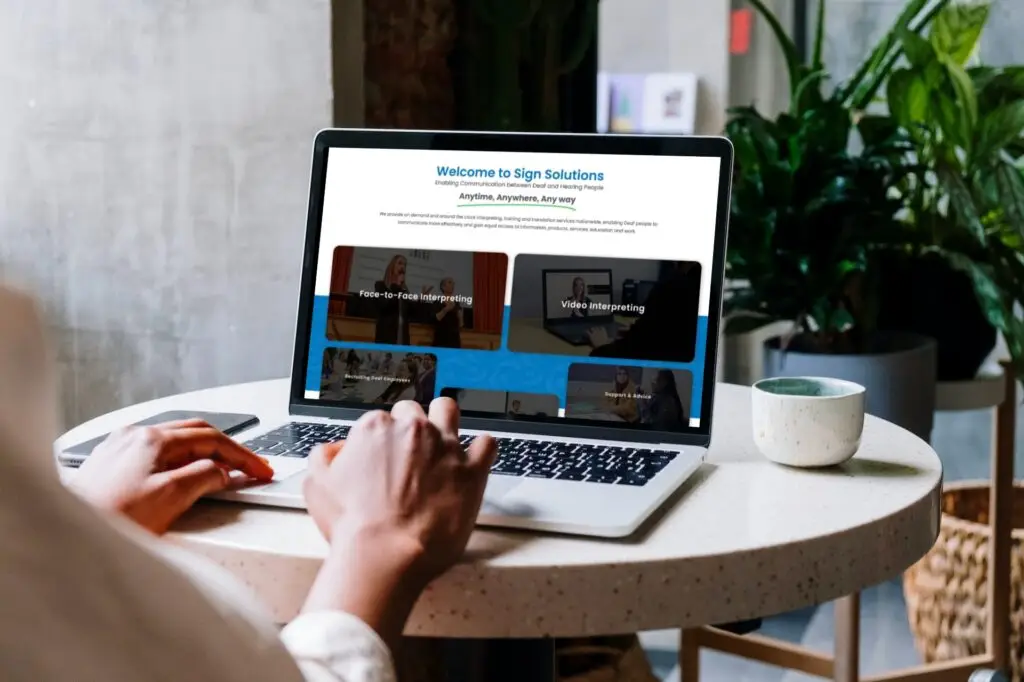If your website isn’t generating enough quality leads, it’s not doing the best job it can for your business.
That opening statement is as true today as it was when we first published this article back in 2022. However, a lot has changed in search since then. We’ve updated this blog with our latest thinking to help you get your website into the best shape possible, so you can benefit from these changes.
Your website is often the first point of contact with your potential customers. It needs to be optimised and designed to connect with potential customers easily and quickly, to produce quality sales and leads.
One of the biggest challenges many businesses face is figuring out how to get more leads and sales from their website. You could be running multiple social media campaigns and sending out regular emails to your customer base, but without a great endpoint for your customers to get to, it’s all wasted.
Think of your website as a bucket and your marketing as water. You wouldn’t pour water into a bucket with holes in it! First, you need to fix the holes – the heart of the problem.
So, what’s changed?
The search landscape evolved significantly in 2023 and 2024, with Google placing heightened emphasis on authentic, experience-based content through its expanded E-E-A-T guidelines. The addition of ‘Experience’ as a key factor means websites must now demonstrate genuine first-hand knowledge alongside traditional expertise and authority signals.
AI-powered search capabilities, such as Google’s AI overviews, have become increasingly prominent, with users expecting more sophisticated, conversational search experiences. Natural language processing has advanced significantly, making it crucial for sites to optimise for both voice and traditional text queries.
Google has also started to consider digital sustainability in its ranking decisions. Websites using eco-friendly hosting solutions and optimised resource loading may see advantages in their search rankings.
And mobile-first indexing has evolved to prioritise sites that cater for voice, image and even video search, while personalisation has become increasingly sophisticated, with users expecting tailored experiences based on their behaviour and preferences across all their devices.
Four reasons your website isn’t generating leads
One clear indicator that your website needs work is high bounce rates. Bounce rate is the percentage of users who land on your website, and leave without moving elsewhere in the navigation. If your bounce rate is high, it could be down to a number of factors:
Unresponsive & outdated
If you’re a long standing business, and haven’t updated or refreshed your website in say 5 years or so, this will be having a huge impact on leads and sales. Technology and what we can do with it has changed so drastically over the last decade that its crucial businesses stay up to date to not only showcase products or services but to give customers the best user experience possible.
Lack of engaging content
Engaging content is paramount to having a successful website. In Google’s ‘Helpful Content Algorithm update (August 2022) it stated that the search engine will now aim to boost content written for people, by people. By generating more engaging content for your website, through your standard pages and through blog articles, this will not only put you in Google’s good-books, you’ll also see an increase in sales and leads.
No call to action (CTAs)
One of the best ways to get people to engage with your website is by telling them what action to take, like ‘click here’, ‘book now’ or ‘buy now’. Consumers want the easiest journey possible when it comes to the buying process, so without clear directives and CTAs, your website isn’t going to give you the results you want.
Slow loading speeds
There’s nothing more frustrating than a website that doesn’t load fast enough. Consumers are impatient, and if your website isn’t loading after 2 or 3 seconds, there’s a high chance they’ll look elsewhere.

We identified the above four factors when we first published this article in 2022. However, since then, the following issues may also have an impact:
Poor AI-powered search integration
With the rise of AI-powered search, users now expect more intelligent and conversational search experiences. If your web content isn’t optimised to provide relevant results based on user intent rather than just keywords, you’re likely losing potential customers who can’t find what they’re looking for.
Lack of mobile-first optimisation for voice search
As voice search continues to grow, especially on mobile devices, websites that aren’t optimised for long-tail voice queries are missing out on significant traffic. Google’s mobile-first indexing now heavily prioritises sites that cater to voice search patterns.
Insufficient trust signals for E-E-A-T
Google’s updated E-E-A-T guidelines (Experience, Expertise, Authoritativeness, and Trustworthiness) mean websites need to demonstrate first-hand experience alongside expertise. Without clear author credentials, customer testimonials, detailed case studies and authentic experience-based content, your website may struggle to rank well and convert visitors.
No personalisation
Users now expect websites to remember their preferences and provide tailored experiences. Without implementing smart personalisation features like AI-driven product recommendations, personalised content delivery or dynamic pricing based on user behaviour, your website may see lower engagement and conversion rates.
Poor Core Web Vitals performance
While loading speed was important in 2022, Google’s Core Web Vitals have become even more crucial. Sites need to be optimised for all three metrics: Largest Contentful Paint (LCP), First Input Delay (FID), and Cumulative Layout Shift (CLS). Poor performance in these areas directly impacts both rankings and user experience.
Insufficient multi-device continuity
Users expect seamless experiences across devices. Websites that don’t offer features like cross-device shopping cart preservation, synchronised wish lists or continuous browsing history may lose sales in a multi-device user journey.

How to get more sales and leads from your website
As we said above, a lot has changed in search over the past two years.
The onset of generative AI-powered search results, Google’s renewed focus on people-first, helpful content, and its updated E-E-A-T guidelines have all had a significant impact on how websites are indexed and displayed in its search results.
However, while the latest developments and trends have no doubt had an impact on search performance, the basics haven’t changed. Helpful content, effective design, simple navigation and user experience, mobile responsiveness and good SEO are still the essential ingredients of a successful website. Focus on getting these foundations in place, and you won’t go far wrong.
To meet the demands of our tech-saturated world, many people are turning to the internet for information. In this digital age, it’s critical that your website has user-friendly features, is regularly optimised and updated, and has the correct tracking in place, to perform in the best way possible.
In the original version of this blog, we recommended several key areas to look at for improved website sales and conversions, including:
Think mobile
In this digital age, having a mobile friendly website is a necessity. So many customers use mobile devices or tablets when researching services and products, so it’s essential to have a responsive and adaptable website that suits almost any screen size.
Add forms to pages
Creating forms on your website whether it be contact forms, quote forms or booking forms is a great way to collect data such as email addresses and phone numbers from potential customers. With that information, you’re then able to add users to email lists, and your CRM to keep them up to date with your company news and slowly nurture them into paying customers.
Improved Search Engine Optimisation (SEO)
Without good SEO, your website won’t be found on the organic listings of Google. By adding keywords within your website content, improving user experience, and starting link building, your website will start ranking higher in SERPs (Search Engine Results Pages). This will result in more visitors that click through to your site, which will in turn boost conversions and sales.
Clear CTAs
Without clear, concise call to actions on your website, it’s difficult to get a good number of converting customers. By including CTAs throughout your website such as ‘get in touch’, ‘talk to us’ and ‘buy today’, it gives a website visitor a better user experience and an easier journey from initially landing on your website, through to purchase or contact.
Analytics
The more tracking and analysis you can do, the more information you will have to work with to improve your website. Metrics like conversion rate, number of visits to your site, traffic sources and who is visiting your website in terms of demographics and locations, are all crucial snippets of data that come together to tell a story of how your website is performing.
In addition to the above, given the changes of the past two years, here are some other things to bear in mind:
- Showcase genuine experience – Create detailed case studies and content that demonstrates your hands-on experience in your industry. Include author bios with specific credentials and experience markers to satisfy Google’s E-E-A-T requirements.
- Optimise for Core Web Vitals – Use tools like Google’s PageSpeed Insights to monitor and improve your Core Web Vitals scores. Implement lazy loading for images, optimise CSS delivery and minimise JavaScript execution time.
- Develop voice search capabilities – Structure your content to answer common voice queries. Create FAQ pages using conversational language and use schema markup to help search engines understand your content better.
- Add personalisation – Implement content delivery that adapts to user behaviour and provides content that changes based on user location and previous interactions.
- Demonstrate sustainability – Choose a green hosting provider and optimise your site’s energy efficiency. Add a sustainability policy page and consider displaying your website’s carbon footprint.
- Enable cross-device continuity – Implement systems that maintain user sessions across devices, such as synchronised shopping carts, wish lists and browsing history accessible from any device.
- Implement semantic SEO – Use structured data markup and natural language processing to help search engines better understand your content’s context and meaning, improving visibility in semantic search results.
- Monitor and adapt to algorithm updates – Set up systems to track Google’s latest algorithm changes and their impact on your site’s performance. Be prepared to adjust your content and technical setup quickly when any new updates roll out.
Implementing the above will stand your website in good stead as search continues to evolve. However, it’s essential to get the basics right first. While trends and innovations come and go, the fundamentals haven’t changed. The most successful websites have always been the ones that combine:
- Helpful content that’s updated regularly
- Logical page structure
- Design that complements the content
- Simple navigation and user experience
- Mobile optimisation
- Strong calls to action
- Clear sitemap
- Good SEO with relevant keywords
Building your website on these strong foundations will put it in the best position to adapt to the latest and future changes in search and ensure it continues to provide the leads and sales your business needs to grow.
How can a QBD website help increase your leads and sales?
In today’s digital marketplace, simply having a web presence isn’t enough. Instead, your website needs to work hard for you and your business and make your customers feel connected with your brand. It needs to be responsive, user-friendly and take your customers and prospects on a journey they will remember. It also needs to be optimised to reach your ideal audience, and safe and secure to give your visitors peace of mind.
A website from QBD can do all this and more. We’ll take the time to understand your business and objectives before delivering a solution that meets your needs. Whether you’re looking to sell more online, reach more customers or raise awareness of your brand, our friendly team of creative, technical and digital experts can help.
About the authors

Molly Sneath
Molly is our PPC & Digital Marketing Specialist.
As well as managing QBD’s marketing activities, she supports multiple clients and projects with her skills in SEO, social media management and Pay-per-click, specifically Google Ads. She also has strong copywriting skills and writes blogs for clients who have a monthly subscription with us.

Jon Smart
Jon is our Head of Creative Content. He works with a range of QBD clients, producing engaging, SEO-friendly website and digital content to help them reach a wider audience. He does this by gaining a deep understanding of who our clients are, what they do, who their customers are and what makes them special, then helps them to tell their brand story in a way that connects with their target audiences.

